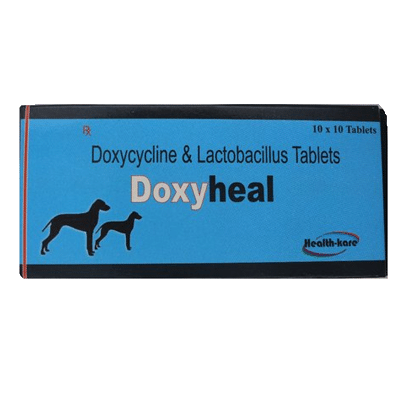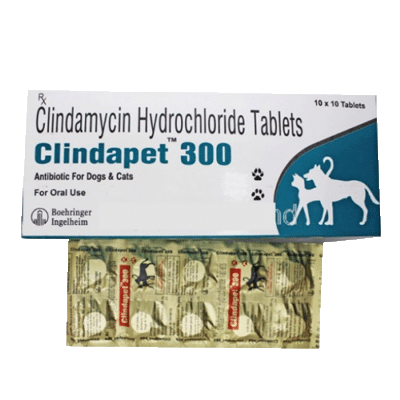The drug helped the dog cope with a respiratory infection. After several days of use, its condition noticeably improved: the cough went away, breathing returned to normal, and activity appeared. No side effects were noticed, the dog took the pills without problems, especially if they were hidden in food.

Doxycycline (Doxyheal)
Active ingredients: Doxycycline- Quality products
- Support 24/7
- Fast delivery
What is it?
Doxyheal is a veterinary drug containing doxycycline, an antibiotic from the tetracycline group. It is used to treat a variety of bacterial infections in animals, including respiratory, genitourinary and skin infections. Doxycycline is effective against a wide range of bacteria, making Doxyheal a useful drug in veterinary practice.
Composition
Doxyheal contains the active substance doxycycline, which belongs to the group of tetracycline antibiotics. It affects bacterial cells, suppressing their growth and reproduction. The composition of the drug may also include auxiliary components that improve the absorption of the active substance and ensure its stability.
- Doxycycline is the main active component with antibacterial properties.
- Excipients - may include fillers, stabilizers and components for better absorption.
- Release form - usually presented in the form of tablets or powder for solution.
How to use it?
Doxyheal is used strictly according to the instructions, as it is an antibiotic that requires precise dosage. Before use, consult a veterinarian who will determine the required dose depending on the type and weight of the animal.
- Tablets or solution are administered orally, preferably during feeding to reduce the risk of stomach irritation.
- The dosage is calculated based on the animals body weight and the type of infection. Usually, a course lasting from several days to two weeks is used.
- It is important to maintain regular intake and not skip doses, as this can reduce the effectiveness of the treatment.
- Even if the symptoms disappear earlier, the course must be completed in full to prevent the development of bacterial resistance to the antibiotic.
- If side effects occur or the animals condition worsens, contact your veterinarian immediately.
How does it work?
Doxyheal works due to the active component doxycycline, which inhibits protein synthesis in bacterial cells. This leads to disruption of their growth and reproduction, which stops the development of the infection. Due to its broad spectrum of action, the drug is effective against many gram-positive and gram-negative bacteria, including those that cause respiratory, urogenital and skin infections.
After administration, Doxyheal is quickly absorbed in the gastrointestinal tract and reaches a high concentration in the blood. This allows it to penetrate into various tissues and organs, providing a comprehensive effect on the infection. It is important to note that doxycycline retains its activity for a long time, which allows it to be used in relatively low doses. The drug is excreted from the body mainly through the liver and intestines, which reduces the load on the kidneys and makes it safe for animals with renal failure.
Indications
Doxyheal is used to treat various bacterial infections in animals. It is prescribed in cases where it is necessary to suppress the growth of pathogenic microorganisms and prevent complications associated with infectious processes. This antibiotic is effective in veterinary practice due to its high penetrating ability and long-lasting action.
- Respiratory system infections such as bronchitis, pneumonia, and rhinitis caused by doxycycline-sensitive bacteria.
- Urinary tract infections including cystitis, urethritis, and reproductive tract infections.
- Skin and soft tissue infections such as purulent wounds, dermatitis, and abscesses.
- Diseases transmitted by ticks and other parasites including borreliosis (Lyme disease) and ehrlichiosis.
- Treatment and prevention of infections in animals under stress or with weakened immune systems.
Contraindications
Despite the effectiveness of Doxyheal, its use has a number of contraindications that must be taken into account before starting treatment. Violation of these restrictions can lead to undesirable consequences and deterioration of the animals condition. Therefore, it is important to consult a veterinarian before use, especially if the animal has chronic diseases or special health conditions.
- Individual intolerance to doxycycline or other antibiotics from the tetracycline group.
- Pregnancy and lactation in animals, since the drug can negatively affect the development of the fetus and get into milk.
- Liver failure, since the main excretion occurs through the liver, which can increase the load on the organ.
- Age up to a certain period: Doxyheal is not recommended for use in young animals during the period of bone tissue formation, since it can disrupt the development of teeth and bones.
- Combination with other antibiotics, antacids and drugs containing calcium, iron or magnesium, since they can reduce the effectiveness of doxycycline.
Side Effects
Like any antibiotic, Doxyheal may cause side effects, especially with prolonged use or when the recommended dosage is exceeded. Although the drug is generally well tolerated by animals, it is important to closely monitor their condition during treatment. If adverse reactions occur, you should immediately consult your veterinarian to adjust the treatment regimen or select an alternative drug.
- Gastrointestinal disorders, including vomiting, diarrhea, decreased appetite, and stomach discomfort.
- Allergic reactions, such as skin rashes, itching, swelling, or other signs of hypersensitivity.
- Darkening of tooth enamel in young animals with prolonged use, which is associated with the accumulation of doxycycline in bone tissue.
- Photosensitivity - increased sensitivity to ultraviolet light, which can lead to reddening and burning of the skin.
- Impaired liver function with prolonged use or in the presence of a predisposition to liver disease.
Frequently asked questions
Doxyheal Reviews and Experiences
The cat was prescribed Doxyheal for a bacterial skin disease. The treatment took about ten days, but the result was obvious on the fifth day – the fur began to recover, the inflammation disappeared. The only downside was that we had to make sure he didn’t spit out the pill, but overall the tolerance was good.
We treated a rabbit for a urogenital infection, the vet recommended this drug. The improvement came gradually, but without side effects. The main thing is to calculate the dosage correctly and give the medicine at the same time. As a result, the rabbit recovered, and no more problems arose.

